Newari festivals in Kathmandu have great significance and are celebrated with joy. Newari festivals are one of the main attractions for tourists in Nepal.
Newar is an indigenous group of people in Nepal, who are the oldest residents of Kathmandu Valley. The settlement of Newars used to be vast in Kathmandu, Bhaktapur, and Lalitpur districts.
The thick settlement of Newars would celebrate various cultures and festivals that have some religious mythology attached to it.
There are various organizations and social councils of the Newar community that conduct these festivals systematically these days.
They would perform various rituals of festivals and celebrate them by singing and dancing. They also play various unique Newari instruments whose melody is said to be loved by the gods.
The Newar festival always includes a grand feast that consists of several delicious native Newari items.
Those food items are first offered to the gods and goddesses. Then only, the people savor the feast.
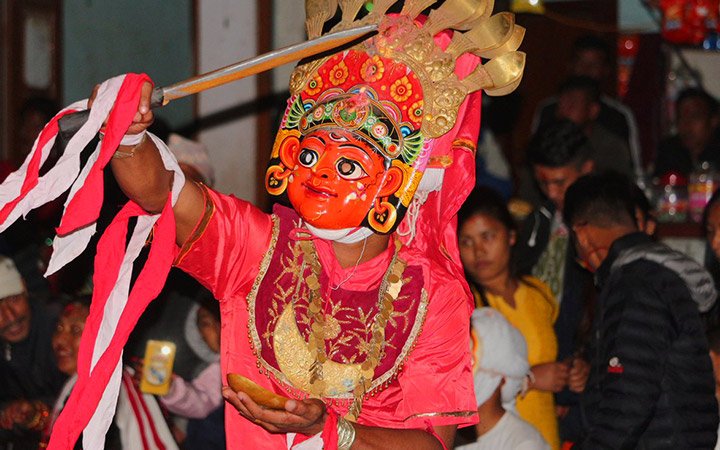
List of Newari festivals
Several Newari festivals are celebrated at specific times of the year. Here isae list of a few Newari festivals that are celebrated with utmost belief and happiness.
Each festival holds a unique significance. Keep reading to find out what those festivals are and how they are celebrated in Nepal.
1) Indra Jatra
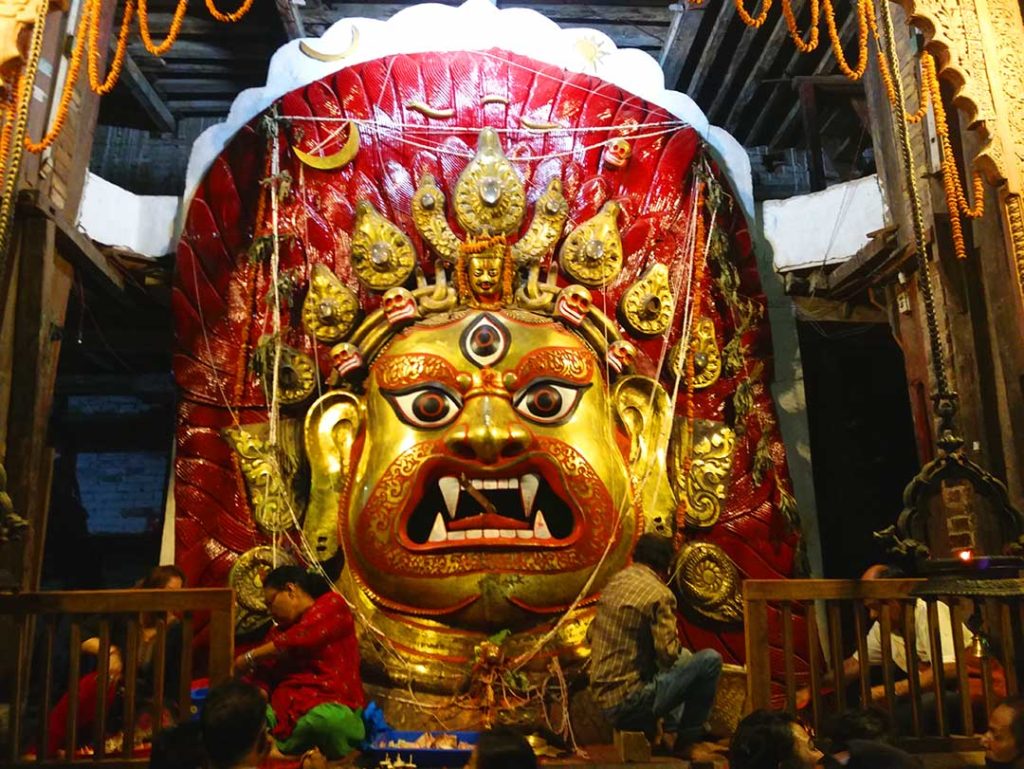
Indra Jatra is aneight-day-longg festival celebrated by the Newar community. Though it is a Newari festival, people of all ethnic groups enjoy participating in Indra Jatra.
During Indra Jatra, the chariot ofthe living goddess Kumari is pulled along with Ganesh and Bhairav. The chariot possession, Lakhe Nach, and Samay Baji are the most enthrallingattractionsn of Indra Jatra.
People from various places come to Basantapur to observe the event. According to Hindu mythology, Indra once visited Kathmandu while searching for his lost pet, Pulukishi.
Indra is the god of rain who descended to the earth from heaven. Indra disguised himself as an ordinary man and started to search for Pulukishi.
When he got tired while searching and took some rest, he saw a beautiful flower blooming. He was so mesmerized by the beautiful flower that he plucked it.
But unfortunately, the flower he plucked was parijat which shouldn’t be plucked. When people saw him plucking the parijat flower, they caught him red-handed and tied him by a rope.
Since he was disguised as a human, no one recognized him. When he didn’t return for long, his mother got worried.
Then, his mother came to earth to find him. When she saw his son tied by a rope, she immediately rescued him by telling the truth to the people.
The local people then apologized to Indra and asked him to spend some joyful time with them. As a result, Indra Jatra is said to be a festival presented to Indra Jatra for his wonderful time on Earth.
A36-foot-long pole known as Linga is erected, which marks the beginning of the festival. Sweta Bhairab, installed in Kathmandu Durbar Square is exhibited for the locals on this day every year. Devotees offer prayers to the deity of Indra installed on the high pedestal at Maru.
2) Bisket Jatra
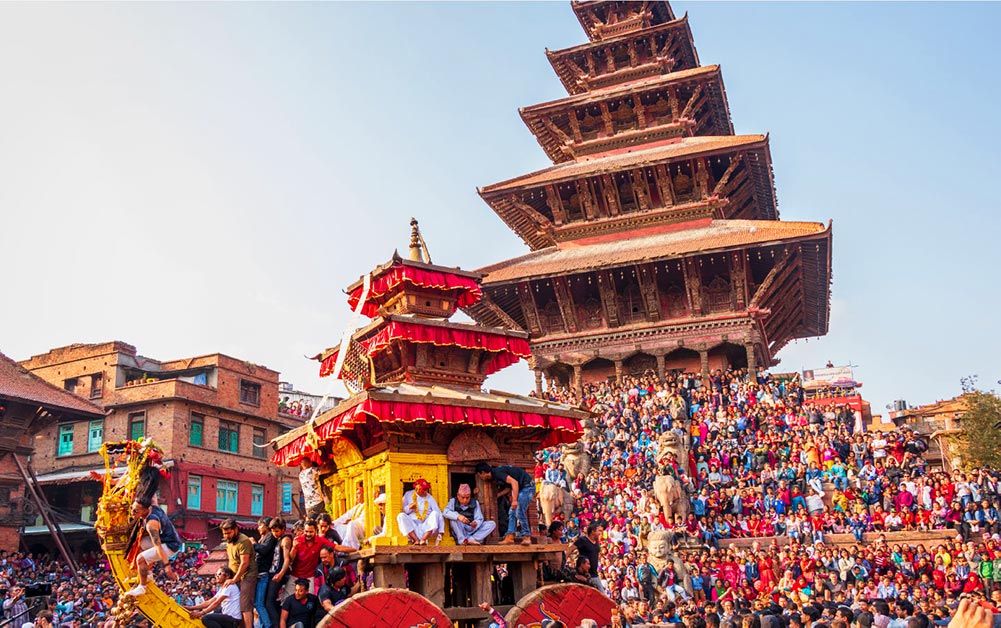
Bisket Jatra, also known as Biska Jatra or Sindur Jatra, is the celebration of the New Year in the Bhaktapur district of Nepal. This festival is not only exciting but also astonishing.
This procession is celebrated for 9 days by pulling the chariots of various gods and goddesses in Bhaktapur. There are various ancient mythologies related to Bisket Jatra out of which one is quite popular.
According to one popular traditional story, a king had a daughter whose husband would die the day after the wedding. Every time his daughter married a man, he would die the very next day of marriage.
An old woman then asks her nephew to marry the princess and also advises him how not to die the next day. According to the suggestion of the old lady, the man marries the princess.
During the night, the husband stays awake and sees two snakes coming out of the princess’s nose. He then killed those snakes and lived happily ever after. It is said that the old lady was goddess Bhadrakali who saved the kingdom from those snakes.
That’s why the chariot of Bhadrakali is pulled across the city during Bisket Jatra. The residents of Bhaktapur worship Bhairav and Bhadrakali and pray for the protection of the country.
A 25m long pole is set, and two long red pieces of cloth is tied from the top that represents the snakes. A kind of competition is held among various groups of people, in which they had to pull the pole towards them.
If the pole falls at their side, it is said to be auspicious, and it also marks the start of a New Year. Similarly, people spread sindur (orange powder) and greet each other.
They play traditional instruments and dance to the tune. Also, some groups of people would pierce their tongues and walk across the streets of Bhaktapur.
3) Yomari Punhi
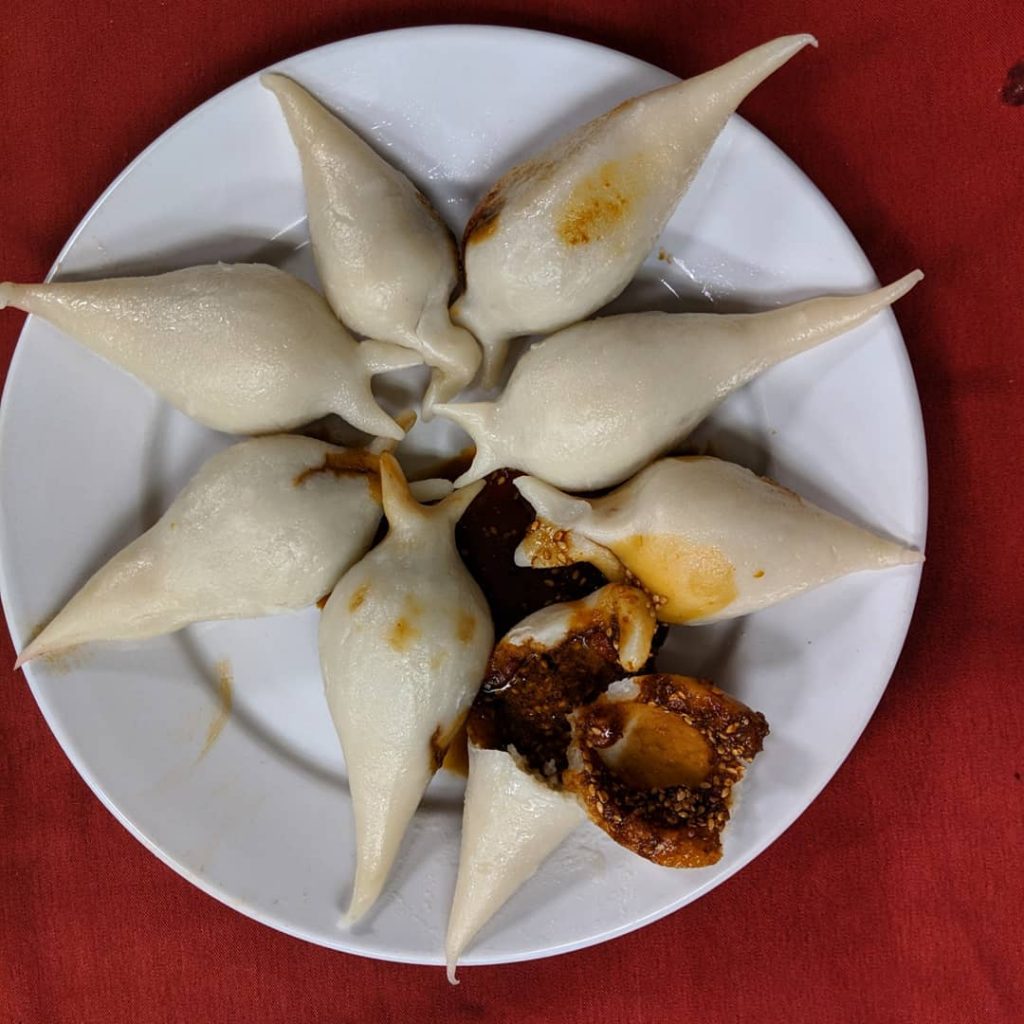
It is the festival of Newars that marks the end of the rice harvesting season. It takes place in November/December during the full moon day of Thinla, the second month in the lunar Nepal Era calendar.
On this day, a special Nepalese food item called yomari is prepared. Slightly triangular and oval-shaped steamed yomari is believed to warm the body.
Yomari is stuffed with various ingredients, and every ingredient carries its ownbeliefsf. Yomari Stuffed with meat is believed to be lord Ganesh, black lentils are Kuber, and yomari filled with chaku is considered Mahamaya.
Few Newar groups go door to door to ask for yomari while singing a Newari song. A grand event is held at Dhaneshwor Mahadev in Banepa.
Yomari festival is celebrated gloriously by organizing fairs in major cities of Newars. The Newari women would wear Haku Patasi and prepare yomari at the fair. People can enjoy the fair and eat yomari along with other special Newari feasts.
4) Gunla
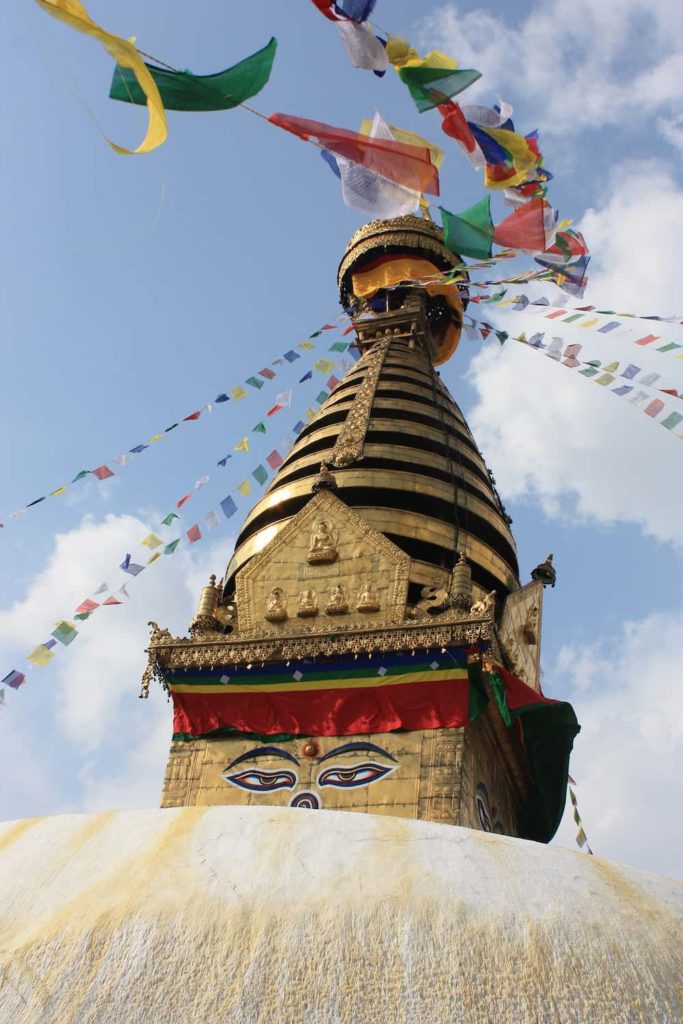
Gunla, a holy festival, holds great significance among Buddhist Newar. In a month-long festival, they take fasts,and read the scriptures and pilgrimages.
Every morning devotees take baths and visit Swayambhunath and Bouddha to offer prayers. They chant mantras while circumambulating the stupa.
It’s very common to hear special music in almost all corners of Kathmandu during this month. Buddha display, Panjaran, Baghi, and Mataya are some of the major days in this month.
Buddha display is an act of displaying the images of Dipankara Buddha and Paubha. On the day of Panjaran, devotees give money and rice to the males of specific Newari castes.
On the day of Baghi, devotees visit four stupas namely Thur, Bagmati Thur, Pucha Thur, and Lagankhya Thur. The parade goes for four days along with four musical bands: Dhime Baja, Damokhin, Khin, and Dha.
Mataya is celebrated by visiting all four stupas visited on Bagi in a single day. It is believed that during ancient times, heavy rainfall used to occur, and because of that people suffered from floods, landslides, and lost their houses.
Thus, to be safe from these calamities people retread to Swayambhunath as it’s in the high altitude. It is believed that King Bikramdev started this festival.
5) Rato Machhindranath Jatra
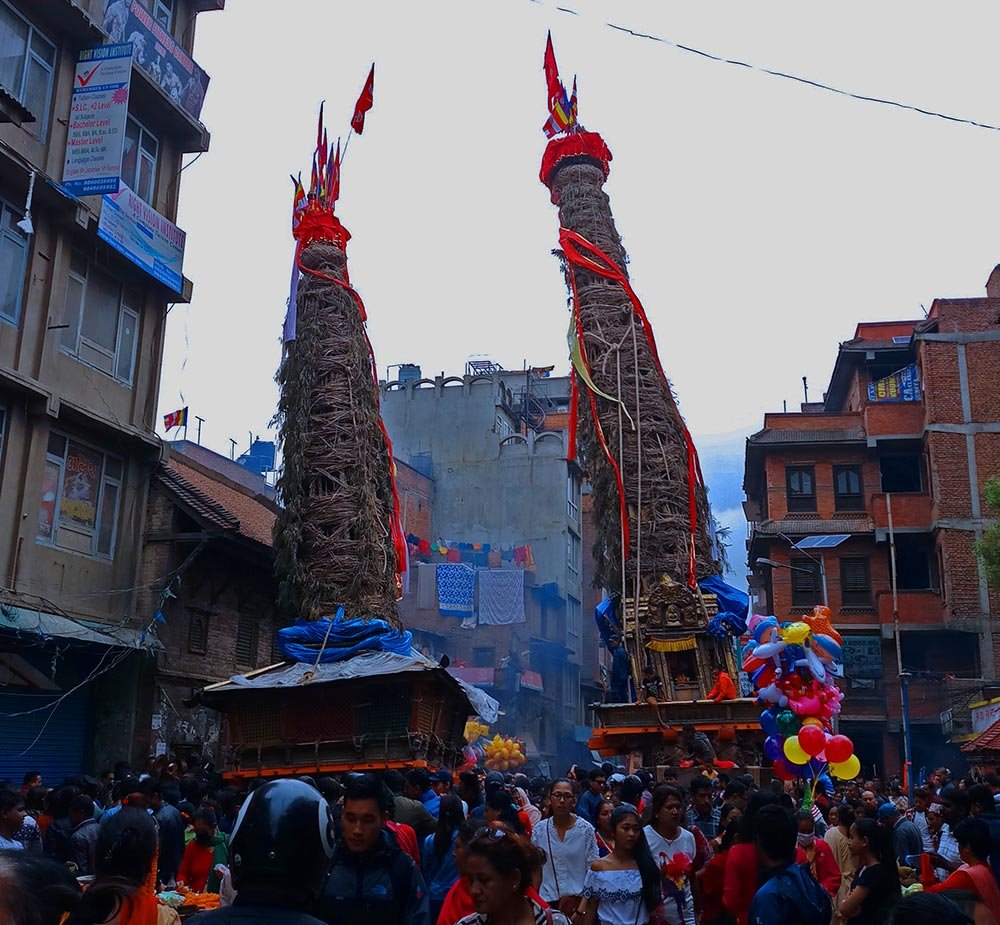
Rato Machhindranath Rath Jatra, the longest chariot festival in Nepal, started around the 11th century. Both Hindus and Buddhists celebrate the festival with great enthusiasm.
Regarded as a god of rain and Shiva’s incarnation in Hindu culture, Rato Machhindranath is revered as a Tantric reincarnation of Avalokiteshvara by Buddhists. The 60-foot tall, hugely decorated chariot is built in Pulchowk, and the festival commences from there.
People from the Newari community drag the chariot through the streets of Lalitpur after installing the image of Bunga Dya. Rato Machhindranath chariot accompanied by a chariot of Chakuwa Dyah tours the narrow streets for a month.
According to Hindu mythology, during ancient times, Kathmandu suffered from drought for 12 years.
The rivers dried, and people started to get worried. Then, the King of Bhaktapur, Narendra Dev, went to meet tantric Shantika.
Tantric Shantika said that Guru Gorakhnath is furious and is meditating on a cushion of 9 powerful serpents. As long as the serpents are not released, the rain will not fall.
For the serpents to be free, Guru Gorakhnanath must stand from his meditation position. It is possible only if his teacher Rato Machhindranath visits him.
Machhindranath, also known as Karunamaya, was reborn as the 108th son of a demon king, Sashi, of Yaksha desh, Assam. King Narendra from Bhaktapur, Tantric Bandu Dutta, and a Jyapu named Ratna Chakra from Lalitpur went to Assam to receive Karunamaya.
The demon king was not ready to give them his child, so the tantric Bandu Dutta summoned four Bhairavs. The four Bhairavs then bring Karunamaya to Bungmati.
Upon seeing Rato Machhindranath, Guru Gorakhnath stands from his mediating position releasing the serpents. And then, it is said that the rain started to fall. The four wheels of the Rato Machhindranath chariot refer to those four Bhaiarvs.
The chariot procession starts from Pulchowk of Lalitpur and is pulled along Natole, Gabahal, Mangal Bazaar, Sundhara, Lagankhel, and Kumaripati. The chariot journey ends in Jawalakhel where the ceremony of Bhoto Jatra is conducted to conclude the festival.
The bejeweled tunic is displayed to mark the end of the festival. Since the festival is celebrated as per the Lunar calendar, it does not have a fixed date.
6) Gai Jatra

Primarily celebrated by the Newari people, Gai Jatra is celebrated as a remembrance of the departed souls. The festival lies in August/September and has a changeable date as it follows the lunar calendar.
The members of the deceased family send a cow for the Parade. In the morning, the cow is bathed and worshipped, they put tika on their body and embroidered them with colorful garlands.
However, the availability of cows has lessened over the period thus young boys are dressed as cows and sent for the procession. As these boys pass through the city, people offer them money, food, and gifts with the hope of getting lucky in the future.
It is a beautiful festival encompassing amusement, laughter, dancing, and singing. The festival lasts for eight days. The festival started in the 17th century after King Partap Malla lost his son.
The demise of the beloved son dragged his queen into the unending misery. His queen would stay sad and depressed all day. The miserable condition of the queen became unbearable to the king.
Every tactic of cheering the queen failed. So to make his queen understand that death is inevitable and everyone has to go through it, he organized the procession where one person from every family that has lost someone during that year should participate.
The locals could say funny things about the powerful people and the social norms on this particular day without fear. The flamboyant procession was to pass along the main gate so that the king and the queen could observe it.
While the parade was passing through the palace, he explained to the queen that the people presented in the festival had lost someone. The queen finally realized she was not the only person who suffered the loss of a loved one and despite that, they were trying to be happy and took part in the festival.
Then, she finally smiled. King’s happiness knew no boundaries and he announced that the festival is to be observed every year.
7) Mha Puja
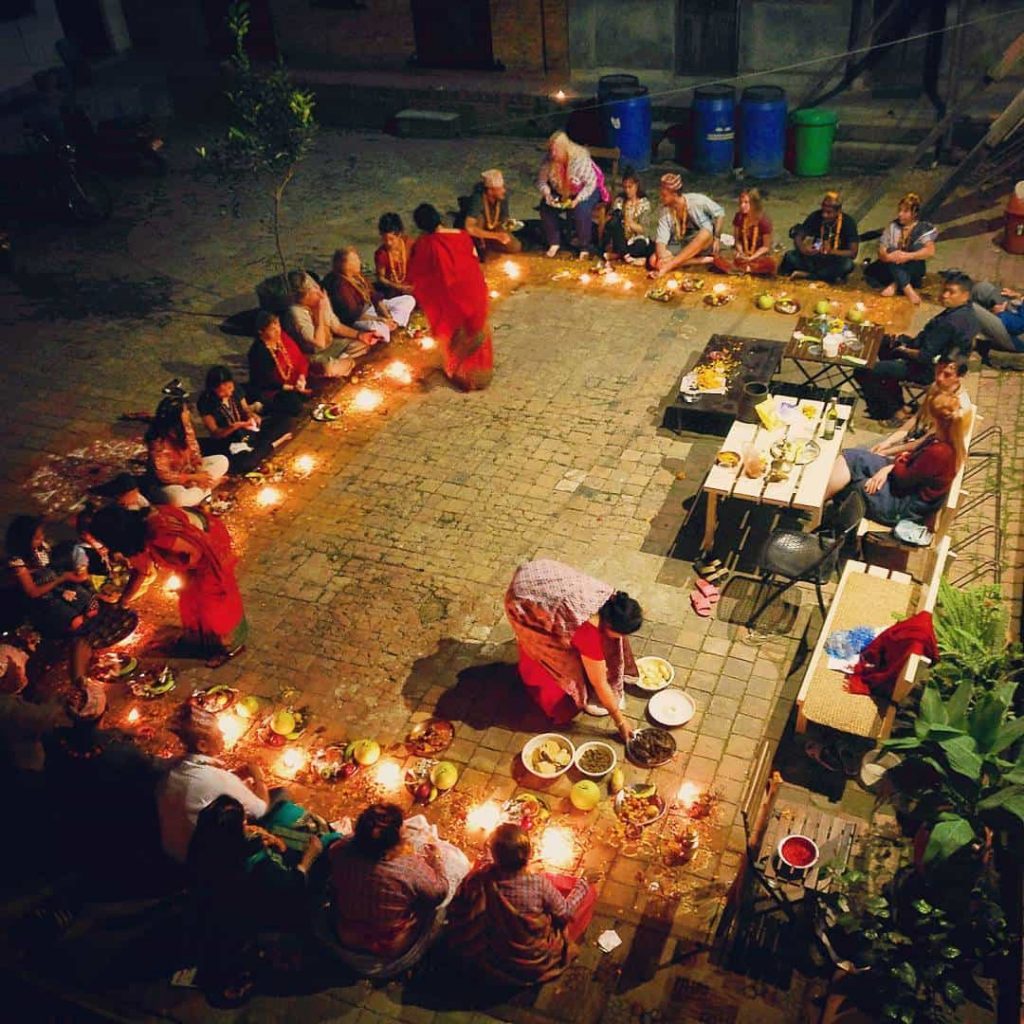
Mha Puja, worship of the self, is celebrated by the Newari community annually to empower and cleanse one’s soul. This festival marks the start of the Newari New Year as well.
It takes place during Tihar: one day after Lakshmi Puja. The same day is also celebrated as Goverdhan and Goru Puja.
The ritual starts with drawing a circular diagram called a mandala on the ground for every single member of the family. Two more Mandalas are drawn for messengers of death.
Additional diagrams are drawn for the household items like a broom, winnowing tray, and water pitcher. After offering prayers to the mandala along with ritual food, flowers, incense, sacred thread, etc, they sit in front of the Mandala with the crossed leg.
The lady from the house puts a tika on their forehead and places a long burning wick next to the mandala then offers them fruits and sacred threads. In the next part, women walk down the line with a pot filled with curd, every member offers some curd to one’s temple.
The members are given ritual food. At the end of the ritual, every family member enjoys the feast. The bronze plate filled with food is placed above the mandala.
The main menu comprises eight items signifying eight grandmother goddesses who are considered as protectors. After the feast, they leave the room as it is and clean everything including plates and floor only the next day.
8) Kuchhi Bhoye

Kuchi Bhoye, a Newari Feast takes place on the eighth day of Dashain. The eighth day of Dashain is also known as Maha Ashtami.
On this day, the Newar community celebrates Kuchhi Bhoye by preparing their signature style of native dishes. It’s a grand feast that brings the family together in chatter, laughter, and fun.
Everybody from the family gathers at the home of the oldest members. All the family members sit on the ground for the bhoj.
Several dishes are served on a banana leaf. 25 to 30 different veg and non-veg dishes are served including Aila (a local liquor), Samay baji, choila, aloo ko achar, Khasi ko masu, bodi, bara, Bhutan, bhatmaas, aloo Tama, sidra, etc.
This Newari festival strengthens the family bond since family members gather at one place and enjoy the time together eating feast.
9) Chaite Dashain
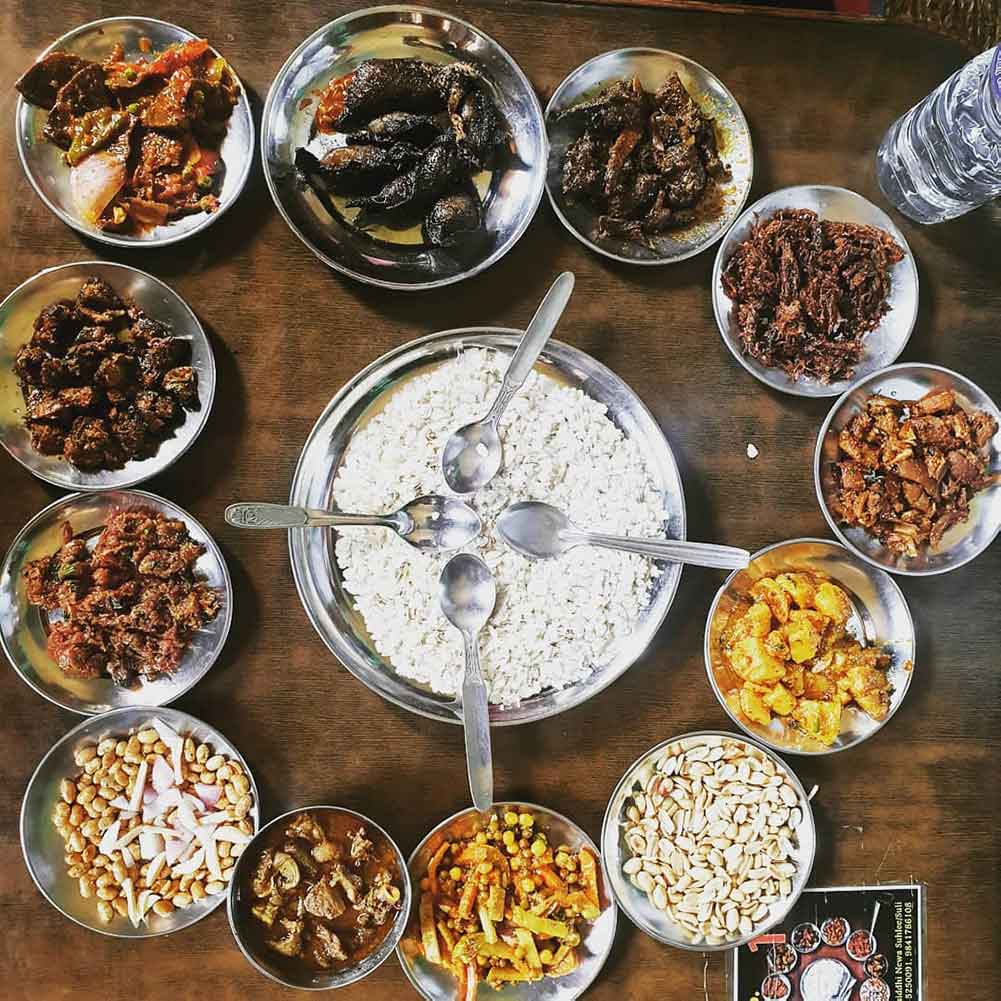
Chaite Dashain is observed in Chaitra, the last month of the year according to the Bikram Sambat calendar. The festival lasts only for two days.
On the first day, Ram Nawani is observed and on the second day Dashami. The festival holds the same significance as the 10th day of Bijaya Dashain.
During Ram Nawani, devotees keep fast and offer prayers in Lord Ram’s temple. During chaite Dashain, Hindus worship Goddess Durga and sacrifice animals to please the goddess.
According to Hindu mythology, Ram, an incarnation of Lord Vishnu was born on the day of Ram Nawami.
Thus, people started to fast and offered prayers to celebrate this day. And Chaite Dashain is celebrated as the day Ram returned to Ayodhya from 14 years of exile with his wife Sita and brother Laxman.
10) Mohani

Newa’s Dashain, Mohani holds great significance among Newari people. Like any other festival in Nepal, this festival as well brings the families together under the same roof.
Family gatherings, pilgrimages, religious services, and celebrations that last for several days make this festival awaited. Since bhoj is an integral part of the Newari community, this festival as well features special dinners that continue for weeks.
Mohani is a celebration of the triumph of good over evil. Though the festival is celebrated for more than two weeks, the most important events occur from the 8th to the 11th day of the festival.
On the first day, barley seeds are planted in the sand in earthen bowls in the room where the deity is installed. On the fifth day, a parade is held to honor the deity Panchali Bhairav.
On the eighth day, Sikali Jatra takes place which encompasses religious rituals and dance performances. Lakhe dance is observed in Bhaktapur for five days.
On the same day, a special bhoj, Kucchi Bhoye, is held. Around 30 mouth-watering dishes are prepared on this day.
Sacred rituals like worshipping metal tools are performed on a ninth day. The tenth day is called Chalan.
On this day, family members gather in the shrine room and receive tika and blessings from the elders. After that, another grand feast is organized.
During Mohani, most of the people indulge themselves in traditional sport, Kite flying. It is believed that the kite takes the message to heaven to end the rains for the year.
As per Hindu mythology, Durga, the Goddess of power slew the evil-spirited Mahisasur who was creating havoc in the world. After a multi-day war, Durga finally killed him.
Durga’s triumph over Mahishasur is proof that evil cannot win. Likewise, the demon Chunda was killed by Goddess Chamunda. So to celebrate the victory of right over wrong, Mohini started.
At the End
Newar has the most varied and interesting festivals. Apart from the festivals mentioned above, the Newar community celebrates many more events.
But one thing is always common, and that is the exotic ‘Bhoj’. You will always find yourself amid interesting events throughout the year.
Thus, you will always get a rewarding festive experience no matter the time of the year you are visiting Nepal.
I hope after reading the Newari Festivals blog post, you get to know more knowledge about newa culture.
If you have any feedback please feel free to comment below or email us.
cool 😎and ty
Welcome